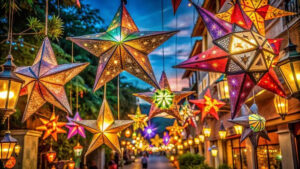
Christmas in the Philippines is one of the most vibrant and widely celebrated holidays in the world. The Philippines is known for having one of the longest Christmas seasons, with celebrations starting as early as September and lasting until the Feast of the Epiphany in January. This festive spirit is deeply rooted in the Filipino’s strong Catholic faith and cultural traditions.
Traditions
One of the most iconic Filipino Christmas traditions is the Simbang Gabi (Night Mass). This nine-day series of early morning Masses, held from December 16th to 24th, culminates in the Misa de Gallo (Rooster’s Mass) on Christmas Eve. It is believed that if one attends all nine masses, they will receive special blessings. Another beloved tradition is the Noche Buena, the Christmas Eve family feast, where relatives gather for a late-night meal after the Misa de Gallo.
Filipinos also celebrate Parol (Christmas lanterns), which are a symbol of the Star of Bethlehem. These lanterns are made from bamboo and colorful paper, often in the shape of a star, and are displayed on homes, streets, and churches. The Parol represents hope and the Filipino’s enduring faith in Christ.
Food
Food plays a central role in Filipino Christmas celebrations. The holiday season is marked by an abundance of delicacies, both savory and sweet. On Christmas Eve, families indulge in Noche Buena, which includes traditional dishes like lechon (roast pig), hamon (Christmas ham), like fiesta ham, brick ham with fruits like grapes , queso de bola (edam cheese), quezo de bola, magnolia and Pato and pancit (noodles, symbolizing long life). Sweet treats like bibingka (rice cake), puto bumbong (purple rice cake), and empanada (pastry filled with meat or vegetables) are also commonly enjoyed during this time.
For many Filipinos, the Christmas season is not just about the main feast but also about sharing food with neighbors, friends, and extended family. Kanto (street food) vendors selling delicacies such as kakanin (sweet rice cakes) are a common sight in many areas during Christmas.
Giving gift baskets is a Filipino tradition, especially among businesses and between family and friends. These gift baskets, known as regalo, are often filled with goodies like canned goods, chocolates, fruit, wines, coffee, sweets such fruit cake or food for the God, and other food items. They are an expression of love, generosity, and goodwill. Some families also exchange monetary gifts or small tokens, with children receiving gifts from their godparents during the Christmas season.
Fun Facts
1. Longest Christmas season, The Christmas season in the Philippines officially begins when the “ber” months start in September and ends in early January. This gives Filipinos over four months of celebrations.
2. Unique Christmas carols, Filipino Christmas carols are often more religious than their Western counterparts. Popular songs like : Pasko na Naman and Ang Pasko ay Sumapit are sung by carolers, spreading festive cheer to homes and communities.
3. Giant lantern festival, In the city of San Fernando, Pampanga, the Ligligan Parul (Giant Lantern Festival) is held every December. This festival features huge, intricately designed lanterns, which are lit up in a dazzling display of lights and colors, drawing thousands of visitors each year.
In conclusion, Christmas in the Philippines is a unique blend of religious devotion, family bonding, and vibrant cultural celebrations. From the joyful Simbang Gabi and the festive Parol to the mouthwatering food and generous gift-giving, Christmas in the Philippines is truly a special and heartwarming time of the year.

